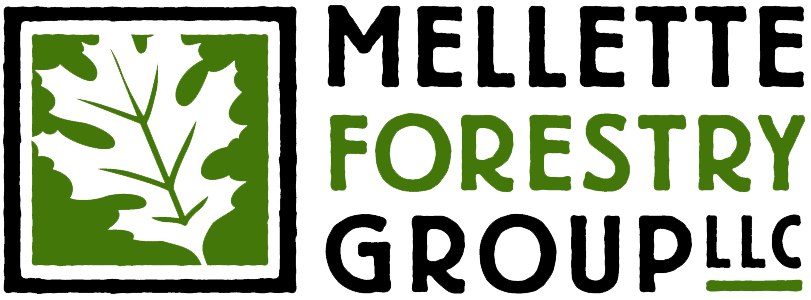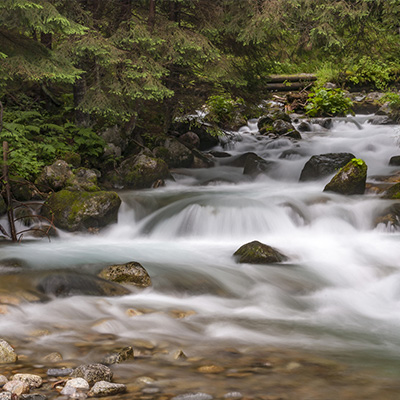Management Plans, Timber Inventories, Insect & Disease Surveys
Forest Management Plans
Forestry is a long-term proposition. Planning and setting goals are important for forestland management. The forest management plan is a blueprint for the forest landowner to follow. It enables the landowner to monitor his progress, and in the case of the Family Forest, is a document to remind the heirs of what the previous generation wanted to accomplish and what they considered to be important.
What is Forest Management?
A Forest Management Plan includes Best Management Practices (BMP's), which protect rivers and streams. Managing a forest provides the proper care so that it remains healthy and vigorous, producing and enhancing the products and amenities that the landowner desires. Forest management is a process that is as dynamic and changing as the forest itself.
The forest management plan should be neither lengthy nor complicated, easy to understand, and easy to modify as circumstances change. The forest management plan states the landowner's goals and objectives, provides a timeline in which the landowner attains those objectives, and allows the landowner the opportunity to modify the objectives, if necessary.
Steps for Developing a Forest Management Plan
Identify Objectives: Set goals that you want to see accomplished in the future. The reasons people own forestland are varied and can include one or more of any of the following objectives:
- Source of Income
- Soil Stabilization
- Aesthetics
- Preservation
- Inheritance
- Wildlife Habitat
- Recreation
Resource Inventory: Once ownership objectives are defined, resources can be inventoried. The resources to be inventoried include: timber (see Timber Inventory section), property boundaries, wildlife habitat, streams, trails, roads, campsites, scenic vistas, and easements. New technology such as GPS and data recorders can be used to make the inventory work easier.
Develop and Implement the Strategy: A simple and concise written plan stating the management objectives and a schedule of forest management activities will provide the basic guidelines for the forest management program.
Periodic Review: Changes in ownership, objectives, forest inventory, and/or the business climate can all result in the need for modification of the forest management plan. The review should take place every 5 to 10 years, or more frequently as circumstances change.
Timber Inventory (Valuation/Cruise)
A timber inventory (timber cruise) can be necessary for a number of reasons:
Selling Timber; Timberland Acquisition; Forest Management Planning; Estate Planning; Forestry Investment Analysis; and, Timber Damage Appraisal
The timber cruise, or timber inventory, is the starting place for timber valuation. Until the forest landowner knows the volume of timber on a property, he/she cannot know the value of the timber."A forest inventory is the procedure for obtaining information on the quantity and quality of the forest resource and many characteristics of the land area on which the trees are growing. A complete forest inventory for timber evaluation provides the following information: estimates of area, description of topography, ownership patterns, accessibility, transportation facilities, estimates of timber quantity and quality, and estimates of growth and drain [removals]."
Timber Cruise Methods
Foresters use a number of different timber cruising methods, including strip, fixed-plot, variable radius, and 100% cruises. The first three methods measure a small sample of the trees. A conversion factor based upon a ratio of the total timbered area to the area in the sample expands, or "blows up," the sample in order to compute the total volume of timber. A forester may perform a 100% cruise on a small tract of high-value timber. With a 100% cruise, the forester measures each tree on the property.
The most common timber cruise is a systematic sample. In a systematic sample, plots are laid out in a grid fashion, evenly distributed, so as to sample all of the different timbered areas. The forester usually measures distances in the woods by "chains." A chain is 66 feet and has been a common unit of measurement in forestry for years.
A timber cruise can be compared to a public opinion poll. As long as the polltakers cover a broad spectrum of the overall population, the results of the poll will be relatively accurate. If the pollster questions twice as many Democrats than Republicans, then the chances are good that the polling results will be significantly skewed. Therefore, a poorly designed timber cruise will result in unreliable timber values. We will specify the type of cruise we are performing and will include a field map or sketch showing the location of the sample plots in our timber cruise report.
Timber value also depends on tree species. For instance, in the south, pine is more valuable than sweetgum, and in the northeast, cherry is more valuable than poplar. While a landowner may not be expected to be able to identify all of the trees in the forest (and few foresters can, either), when conducting the inventory, the forester must know what products and species have the highest value in the subject property's market area. Trees of North America: A Guide to Field Identification is an excellent field guide for tree identification.
Mellette Forestry Group can help a land owner know how much timber is on the property and what it is worth by providing an accurate timber cruise. Our Timber Inventory services cover all size forestland properties, from a few acres to thousands. Contact us and let us design and implement the appropriate timber inventory for your forestland.
Insect and Disease Survey
Forests can be devastated by insect infestations or tree diseases. Knowing how to recognize a problem and taking the correct action can possibly save millions of dollars’ worth of timber. We work closely with the State Forestry Agencies to survey and control a variety of forest pests. Immediate and decisive action by the forest landowner can have a significant effect on forest health.
Two of the most troublesome insects of southern forests include the Southern Pine Bark Beetle (Dendroctunus sp.) and the Hemlock Woolly Adelgid (Adeles tsugae).
THE SOUTHERN PINE BEETLE
The southern pine beetle (SPB) is the most destructive pine bark beetle in the south. Randomly flying females locate weakened trees which are called focus trees. Focus trees then become the source of an attracting pheromone called frontalin that attracts other flying beetles. As the focus trees become less attractive due to the male pheromone verbenone, incoming beetles begin to attack neighboring trees. This switching mechanism causes the infestation to grow.
The SPB attacks all species of Southern Yellow Pines including Eastern White Pine. It is particularly destructive in overmature and overcrowded timber stands. Beetle outbreaks are cyclic and usually follow drought, which weakens pine trees, making them susceptible to beetle attacks.
Trees are killed when thousands of adult beetles bore underneath the bark to feed and lay eggs. The female beetles construct winding S-shaped galleries in the cambium while feeding and laying eggs. Adult beetles carry blue stain fungi, which clogs water movement in the sapwood, drying the needles and killing the tree.
The usual signs of pine beetle attack will be pitch tubes on the outside of the bark, which look like small pieces of popcorn. The needles eventually turn pale to yellow-green (called faders), then red, then brown.
The removal of all infested trees by salvage is the best means of controlling Southern Pine Beetle spots. Another method of control is cut-and-leave. This method involves felling infested trees along with a buffer of uninfested trees and leaving them in the forest. Cut-and-leave should only be done when the trees can’t be salvaged, and only during the summer months.



